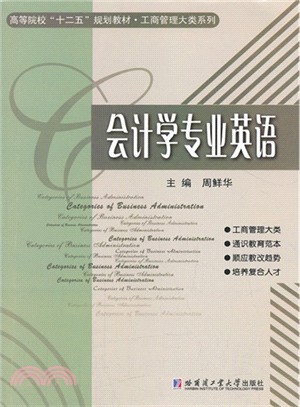商品簡介
目次
書摘/試閱
相關商品
商品簡介
《會計學專業英語/高等院校“十二五”規劃教材·工商管理大類系列》是一本為會計英語教學而編寫的專業基礎教材,內容以基礎會計理論、財務會計為主,兼顧財務報表與分析的主要內容。《會計學專業英語/高等院校“十二五”規劃教材·工商管理大類系列》共有9章,每章由開篇案例、課文、單詞術語注釋、拓展閱讀等組成。
通過對《會計學專業英語/高等院校“十二五”規劃教材·工商管理大類系列》的學習,可以使讀者掌握會計學基本理論、基本方法的英語表達方式,對拓展會計專業英文詞匯、提高運用英語處理會計業務的能力,閱讀會計專業英文文獻等大有助益。《會計學專業英語》可作為高等院校本科、高職、高專會計、審計、財務管理等專業的會計英語課程教材,也可作為廣大財會從業人員學習會計英語的專業書籍。
通過對《會計學專業英語/高等院校“十二五”規劃教材·工商管理大類系列》的學習,可以使讀者掌握會計學基本理論、基本方法的英語表達方式,對拓展會計專業英文詞匯、提高運用英語處理會計業務的能力,閱讀會計專業英文文獻等大有助益。《會計學專業英語》可作為高等院校本科、高職、高專會計、審計、財務管理等專業的會計英語課程教材,也可作為廣大財會從業人員學習會計英語的專業書籍。
目次
Chapter 1 The Accounting Introduction
Unit 1 Accounting and Accounting Profession
1.1 Introduction to Accounting
1.2 Distinction between Bookkeeping and Accounting
1.3 Divisions of Accounting
1.4 Professional Ethics
Unit 2 Accounting Assumptions
2.1 Separate Entity
2.2 Going Concern Assumption
2.3 Time-period Assumption
2.4 Monetary Unit Assumption
2.5 Accrual Basis of Accounting
Unit 3 Accounting Recognition and Measurement Principles
3.1 Cost Principle
3.2 Revenue Recognition Principle
3.3 Matching Principle
3.4 Conservatism Principle
3.5 Materiality Principle
3.6 Differentiate Capital and Revenue Expenditure
3.7 Substance over Form
Unit 4 Information Users
4.1 Internal Information Users
4.2 External Information Users
Chapter 2 The Accounting Cycle
Unit 1 Accounting Equation and Double-entry Accounting
1.1 Accounting Equation
1.2 Double-entry Accounting
Unit 2 Basics of Accounting Cycle
2.1 Analyze Business Transactions
2.2 Journalize the Transactions
2.3 Post to Ledger Accounts
2.4 Prepare Unadjusted Trial Balance
2.5 Journalize and Post Adjusting Entries
2.6 Prepare an Adjusted Trial Balance
2.7 Prepare Financial Statements
2.8 Journalize and Post Closing Entries
2.9 Prepare a Post-closing Trial Balance
Unit 3 Journals
3.1 The Effect of the Journals
3.2 The Types of Journals
Unit 4 Ledgers
4.1 General Ledger
4.2 Subsidiary Ledger
Unit 5 Adjusting Procedures
5.1 Prepaid Expenses
5.2 Unearned Revenue
5.3 Accrued Expenses
5.4 Accrued Revenues
Unit 6 Closing Process
Chapter 3 Financial Statements
Unit 1 Balance Sheet
1.1 The Concept of the Balance Sheet
1.2 Format of Balance Sheet
Unit 2 Income Statement
2.1 The Concept of Income Statement
2.2 Format of Income Statement
Unit 3 Statement of Retained Earnings
3.1 Introduction to Statement of Retained Earnings
3.2 Influnential Transactions and Events of Retained Earnings
3.3 Appropriation of Retained Earnings
3.4 Statement of Stockholders Equity
Unit 4 Cash Flow Statement
4.1 The Purpose of Cash Flow Statement
4.2 The Classification of Cash Flows
4.3 The Basic Approach to Prepare the Cash Flow Statement
Chapter 4 Current Assets
Unit 1 Cash and Its Control
1.1 Cash
1.2 Cash Control
Unit 2 Receivables
2.1 Accounts Receivable
2.2 Notes Receivable
Unit 3 Inventories
3.1 The Concept of Inventory
3.2 Two Basic Inventory Accounting Systems
3.3 Inventory Cost Recognition Method
Chapter 5 Non-current Assets and Investments
Unit 1 Plant and Equipment
1.1 Basic Concept and Categories
1.2 Acquisition Methods
1.3 Post-acquisition Expenditures
1.4 Impairment of Plant and Equipment
Unit 2 Depreciation Method
2.1 The Reason of Depreciation
2.2 Methods of Computing Depreciation
Unit 3 Basics of Investments
Unit 4 Intangible Assets
4.1 Basic of Intangible Assets
4.2 Leading Examples of Intangible Assets
Chapter 6 Liabilities
Unit 1 Current Liabilities
Unit 2 Non-current Liabilities
Chapter 7 Revenues and Expenses
Unit 1 Timing of Revenue Recognition
Unit 2 Amount of Revenue Recognized
Unit 3 Expense Recognition
Unit 4 Categories of Expenses
Chapter 8 Owners Equity
Unit 1 Forms of Business Organizations
1.1 Single Proprietorships
1.2 Partnerships
1.3 Corporations
Unit 2 Accounting for Proprietorships Equity
2.1 Accounting for the Owners Equity in a Single Proprietorship
2.2 Capital Account
2.3 Drawing Account
2.4 Financial Statements Presentation
Unit 3 Accounting for Partnerships Equity
3.1 Partnership Accounting
3.2 Division of Net Income and Loss
3.3 Admission of a New Partner
3.4 Revaluation of Assets
3.5 Liquidation of a Partnership
Unit 4 Accounting for Corporations Equity
4.1 Paid-in capital
4.2 Retained Earnings
4.3 Other Reserves
Chapter 9 Financial Statement Analysis
Unit 1 Tools of Analysis
1.1 Horizontal Analysis
1.2 Vertical Analysis
1.3 Ratio Analysis
Unit 2 Solvency Analysis
2.1 Working Capital and Current Ratio
2.2 Quick Ratio
2.3 Accounts Receivable Turnover
2.4 Inventory Turnover
2.5 Debt and Equity Ratios
2.6 Times Interest Earned
Unit 3 Profitability Analysis
3.1 Return on Total Assets
3.2 Return on Common Stockholders Equity
3.3 Earnings per Share on Common Stock
3.4 Price-earnings Ratio
3.5 Dividend Yield
Unit 4 Corporate Acquisition and Consolidated Financial Statements
4.1 Corporate Acquisition
4.2 Methods of Accounting for Corporate Acquisitions
References
Unit 1 Accounting and Accounting Profession
1.1 Introduction to Accounting
1.2 Distinction between Bookkeeping and Accounting
1.3 Divisions of Accounting
1.4 Professional Ethics
Unit 2 Accounting Assumptions
2.1 Separate Entity
2.2 Going Concern Assumption
2.3 Time-period Assumption
2.4 Monetary Unit Assumption
2.5 Accrual Basis of Accounting
Unit 3 Accounting Recognition and Measurement Principles
3.1 Cost Principle
3.2 Revenue Recognition Principle
3.3 Matching Principle
3.4 Conservatism Principle
3.5 Materiality Principle
3.6 Differentiate Capital and Revenue Expenditure
3.7 Substance over Form
Unit 4 Information Users
4.1 Internal Information Users
4.2 External Information Users
Chapter 2 The Accounting Cycle
Unit 1 Accounting Equation and Double-entry Accounting
1.1 Accounting Equation
1.2 Double-entry Accounting
Unit 2 Basics of Accounting Cycle
2.1 Analyze Business Transactions
2.2 Journalize the Transactions
2.3 Post to Ledger Accounts
2.4 Prepare Unadjusted Trial Balance
2.5 Journalize and Post Adjusting Entries
2.6 Prepare an Adjusted Trial Balance
2.7 Prepare Financial Statements
2.8 Journalize and Post Closing Entries
2.9 Prepare a Post-closing Trial Balance
Unit 3 Journals
3.1 The Effect of the Journals
3.2 The Types of Journals
Unit 4 Ledgers
4.1 General Ledger
4.2 Subsidiary Ledger
Unit 5 Adjusting Procedures
5.1 Prepaid Expenses
5.2 Unearned Revenue
5.3 Accrued Expenses
5.4 Accrued Revenues
Unit 6 Closing Process
Chapter 3 Financial Statements
Unit 1 Balance Sheet
1.1 The Concept of the Balance Sheet
1.2 Format of Balance Sheet
Unit 2 Income Statement
2.1 The Concept of Income Statement
2.2 Format of Income Statement
Unit 3 Statement of Retained Earnings
3.1 Introduction to Statement of Retained Earnings
3.2 Influnential Transactions and Events of Retained Earnings
3.3 Appropriation of Retained Earnings
3.4 Statement of Stockholders Equity
Unit 4 Cash Flow Statement
4.1 The Purpose of Cash Flow Statement
4.2 The Classification of Cash Flows
4.3 The Basic Approach to Prepare the Cash Flow Statement
Chapter 4 Current Assets
Unit 1 Cash and Its Control
1.1 Cash
1.2 Cash Control
Unit 2 Receivables
2.1 Accounts Receivable
2.2 Notes Receivable
Unit 3 Inventories
3.1 The Concept of Inventory
3.2 Two Basic Inventory Accounting Systems
3.3 Inventory Cost Recognition Method
Chapter 5 Non-current Assets and Investments
Unit 1 Plant and Equipment
1.1 Basic Concept and Categories
1.2 Acquisition Methods
1.3 Post-acquisition Expenditures
1.4 Impairment of Plant and Equipment
Unit 2 Depreciation Method
2.1 The Reason of Depreciation
2.2 Methods of Computing Depreciation
Unit 3 Basics of Investments
Unit 4 Intangible Assets
4.1 Basic of Intangible Assets
4.2 Leading Examples of Intangible Assets
Chapter 6 Liabilities
Unit 1 Current Liabilities
Unit 2 Non-current Liabilities
Chapter 7 Revenues and Expenses
Unit 1 Timing of Revenue Recognition
Unit 2 Amount of Revenue Recognized
Unit 3 Expense Recognition
Unit 4 Categories of Expenses
Chapter 8 Owners Equity
Unit 1 Forms of Business Organizations
1.1 Single Proprietorships
1.2 Partnerships
1.3 Corporations
Unit 2 Accounting for Proprietorships Equity
2.1 Accounting for the Owners Equity in a Single Proprietorship
2.2 Capital Account
2.3 Drawing Account
2.4 Financial Statements Presentation
Unit 3 Accounting for Partnerships Equity
3.1 Partnership Accounting
3.2 Division of Net Income and Loss
3.3 Admission of a New Partner
3.4 Revaluation of Assets
3.5 Liquidation of a Partnership
Unit 4 Accounting for Corporations Equity
4.1 Paid-in capital
4.2 Retained Earnings
4.3 Other Reserves
Chapter 9 Financial Statement Analysis
Unit 1 Tools of Analysis
1.1 Horizontal Analysis
1.2 Vertical Analysis
1.3 Ratio Analysis
Unit 2 Solvency Analysis
2.1 Working Capital and Current Ratio
2.2 Quick Ratio
2.3 Accounts Receivable Turnover
2.4 Inventory Turnover
2.5 Debt and Equity Ratios
2.6 Times Interest Earned
Unit 3 Profitability Analysis
3.1 Return on Total Assets
3.2 Return on Common Stockholders Equity
3.3 Earnings per Share on Common Stock
3.4 Price-earnings Ratio
3.5 Dividend Yield
Unit 4 Corporate Acquisition and Consolidated Financial Statements
4.1 Corporate Acquisition
4.2 Methods of Accounting for Corporate Acquisitions
References
書摘/試閱
Unit 1 Accounting and Accounting Profession
People always think of accounting as a highly technical field whichiS DraCtiCed and understood only by professional accountants. Actually,nearly everyone practices"accounting"in one form or another on analmost.daily basis.
1.1 Introduction to Accounting
Accounting is a process of recording,classifying,summarizing,and interpreting of those business activities that can be expressed inmonetan.ternls. Accounting information affects many aspects of our lives.Whether we are paying our phone bill,balancing our check.book,preparing OUF income tax return,or mana~ng a multinational cot.poration,we are working with accounting and accounting information.
Accountants are persons who specialize in accounting field.Withaccounting knowledgethey are always in demand as they can helpwith financial analysis,strategic planning,product feasibility analysis,and financial management.Accounting frequently offers the qualifiedperson the opportunities to move ahead quickly in todayS businessworld.Indeed,many heads of large corporations throughout the worldhave advanced to their positions from the accounting department.
Accounting is oncn known as one of the most useful tools of busi.ness because all organizations set up an accounting information systemto communicate data and information to help people make better deci—sions.It records the past growth or decline of the business.Careful a.nalysis of these results and trends may suggest the ways in which thebusiness may grow in the future.Expansion or reorganization shouldnot be planned without the proper analysis of the accounting informa—tion;a new product and the campaign to advertise and sell them shouldnot be launched without the help of accounting expertise.
……
People always think of accounting as a highly technical field whichiS DraCtiCed and understood only by professional accountants. Actually,nearly everyone practices"accounting"in one form or another on analmost.daily basis.
1.1 Introduction to Accounting
Accounting is a process of recording,classifying,summarizing,and interpreting of those business activities that can be expressed inmonetan.ternls. Accounting information affects many aspects of our lives.Whether we are paying our phone bill,balancing our check.book,preparing OUF income tax return,or mana~ng a multinational cot.poration,we are working with accounting and accounting information.
Accountants are persons who specialize in accounting field.Withaccounting knowledgethey are always in demand as they can helpwith financial analysis,strategic planning,product feasibility analysis,and financial management.Accounting frequently offers the qualifiedperson the opportunities to move ahead quickly in todayS businessworld.Indeed,many heads of large corporations throughout the worldhave advanced to their positions from the accounting department.
Accounting is oncn known as one of the most useful tools of busi.ness because all organizations set up an accounting information systemto communicate data and information to help people make better deci—sions.It records the past growth or decline of the business.Careful a.nalysis of these results and trends may suggest the ways in which thebusiness may grow in the future.Expansion or reorganization shouldnot be planned without the proper analysis of the accounting informa—tion;a new product and the campaign to advertise and sell them shouldnot be launched without the help of accounting expertise.
……
主題書展
更多
主題書展
更多書展今日66折
您曾經瀏覽過的商品
購物須知
大陸出版品因裝訂品質及貨運條件與台灣出版品落差甚大,除封面破損、內頁脫落等較嚴重的狀態,其餘商品將正常出貨。
特別提醒:部分書籍附贈之內容(如音頻mp3或影片dvd等)已無實體光碟提供,需以QR CODE 連結至當地網站註冊“並通過驗證程序”,方可下載使用。
無現貨庫存之簡體書,將向海外調貨:
海外有庫存之書籍,等候約45個工作天;
海外無庫存之書籍,平均作業時間約60個工作天,然不保證確定可調到貨,尚請見諒。
為了保護您的權益,「三民網路書店」提供會員七日商品鑑賞期(收到商品為起始日)。
若要辦理退貨,請在商品鑑賞期內寄回,且商品必須是全新狀態與完整包裝(商品、附件、發票、隨貨贈品等)否則恕不接受退貨。
























